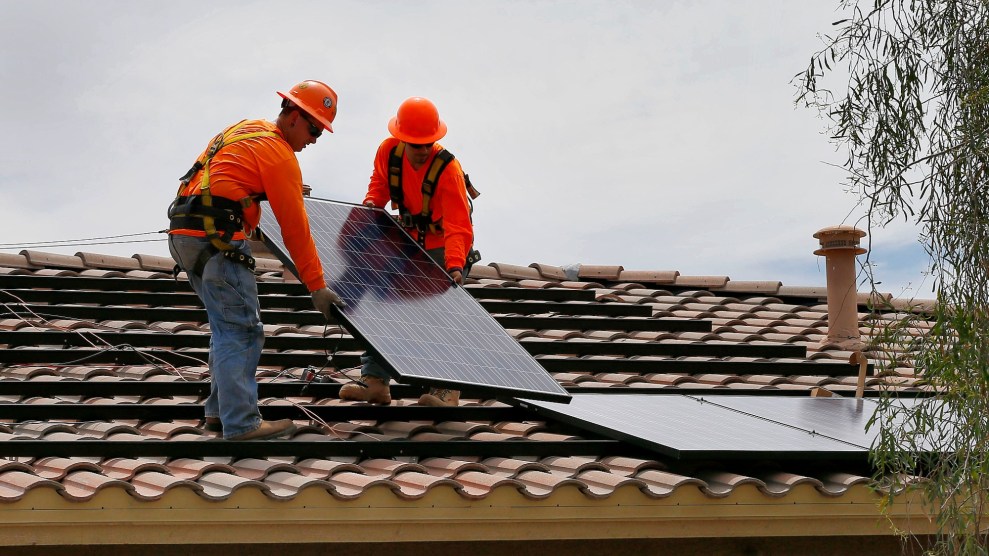
Ivan Pantic/Getty
This story was originally published by Slate and is reproduced here as part of the Climate Desk collaboration.
Two years ago, US Reps. Earl Blumenauer and Jimmy Panetta introduced the Electric Bicycle Incentive Kickstart for the Environment Act, or the EBIKE Act, which proposed giving Americans up to $1,500 off the price of a new e-bike. The bill would’ve catalyzed the adoption of an emerging transportation mode that, among other benefits, can dramatically reduce greenhouse gas emissions when used in lieu of a car.
A version of that bill was incorporated into the climate package that became the Inflation Reduction Act, and it came tantalizingly close to being enacted into federal law. The House included the e-bike incentives in its version of the bill, but at the last minute the Senate left them on the cutting-room floor.
Caron Whitaker, the deputy executive director of the League of American Bicyclists, placed much of the blame on tepid enthusiasm from environmental supporters. Last year she told me, “The real problem is that we haven’t convinced enough climate advocates, both in Congress and the NGO community, that it’s possible to shift enough [e-]bike trips to make a critical difference in greenhouse gases.” The initial introduction of that bill drew only a smattering of endorsements from major environmental groups, with just the Natural Resources Defense Council, Public Interest Research Group, and Ecology Action standing behind it.
Now the e-bike bill is back, with a new version introduced on March 21 in both the House and Senate. But unlike last time, environmental groups are now providing full-throated support. This bill already has much deeper backing from the climate advocacy world, including from organizations like the Sierra Club, Environmental Entrepreneurs, Environment America, and GreenLatinos that were nowhere to be found two years ago (when, notably, Democrats had unified control of Congress).
And now? “There is definitely more awareness of the potential of e-bikes in the climate conversation now,” said Noa Banayan, director of federal affairs for People for Bikes, a bike industry association that has lobbied for e-bike incentives. “It’s come to the forefront for environmental NGOs.”
The expanded alliance supporting e-bikes reflects an evolution in the priorities of environmental groups. After focusing largely (some might say myopically) on electrification as a pathway to decarbonize transportation, many climate advocates are ready to lobby for less driving, period—not just less gas-powered driving. It’s an overdue shift that bodes well for the future of e-bikes and public transit—and for the planet.
Transportation has long been a major source of greenhouse gases in the United States, with cars and light trucks producing more than half of such emissions. There are two basic ways to address that problem: You can make cars pollute less while they are in use, or you can induce people to drive less. As global warming ascended environmental agendas in the 1990s, American advocacy groups focused largely on the former rather than the latter. Improving car fuel economy, not mode shift, was their dominant priority.
“We couldn’t figure out how to pry people away from the steering wheel,” said Dan Becker, who was the director of the Sierra Club’s global warming program during the 1990s and early 2000s. “But people understood that you put bad stuff into cars, and bad stuff comes out the end of them.”
Becker and his allies notched some wins, such as strengthening CAFE fuel-economy standards and mounting withering attacks against the gas-guzzling Ford Excursion (dubbed the “Ford Valdez”), which ceased production in 2005.
But Americans kept driving more miles and abandoning sedans in favor of less fuel-efficient SUVs and trucks. From 1990 to 2020, US emissions from transportation rose 6.6 percent, faster than any other sector.
The solution, many environmental groups concluded, was to electrify the motor vehicles that seemed to be an American addiction. “A large share of global greenhouse gas emissions comes from transportation,” observed the Environmental Defense Fund in 2013. “The most obvious solution is electric vehicles.” In a 2014 explainer about car emissions and global warming, the Union of Concerned Scientists listed “solutions” that included electric cars, cleaner fuels, and fuel-efficient vehicles—but did not mention driving less. Earthjustice’s current website calls electric vehicles “the wave of the future.”
Compared with a reduction in driving, an environmental push for car electrification offered several key advantages. By sidestepping the autocentricity of American land use, it avoided the politically risky implication that people should change their travel habits. Instead, e-cars would allow them to preserve everything about their daily commutes—only now they’d be helping to save the planet when they left their driveway.
Environmental donors, who often shape NGOs’ agendas, were largely on board. “Philanthropies have been very focused on shifting toward electric vehicles,” said Mighty Earth CEO Glenn Hurowitz, “and not so much with mode shift.”
Adoption of electric cars also presented a financial upside to car companies (as well as influential autoworkers unions) that a move toward transit, biking, and walking would not. Over the past decade, many automakers became electrification champions; General Motors made “zero emissions” a part of its corporate vision.
With environmental groups and automakers uniting behind electrification, little airtime remained for those arguing that less driving, period, is necessary to prevent a climate catastrophe—a discrepancy highlighted by a meme that pops up repeatedly on urbanist social media:
In 2018 the discussions around transport were dominated by a single topic: electric mobility#SustainableTransportMeme #ElectricVehicles #EVs pic.twitter.com/Y9g5d5KXPb
— Nikola Medimorec (@ni_medi) January 31, 2019
Multimodal advocates have not wielded much clout, but climate science is on their side. An OECD report from 2020 found that traveling by e-bike or bus (even a diesel-powered bus) creates less emissions than using even an electric car. That same year, a University of Toronto study concluded that the most optimistic forecasts of electric vehicle adoption would still not prevent a disastrous 2-degree increase in global temperatures without concurrent reductions in driving.
Rather than admit the limited benefits of swapping out the 278 million cars in the US for electric models, environmental groups went all in, pushing for EV incentives in last year’s climate bill that began as Build Back Better in the House before becoming the Inflation Reduction Act in the Senate. Their lobbying efforts—along with those of the auto industry—bore fruit: The IRA provides up to $7,500 off an electric car, truck, or SUV.
The House had included a federal e-bike credit in its version of the bill, but the Senate killed it. Banayan, the People for Bikes executive, said climate groups were generally supportive of the e-bike credit but it wasn’t at the top of their agenda. “It’s hard to build the support you need to get it passed when every environmental NGO under the sun has been advocating for their electric car proposals for years, if not decades,” she told me.
As I wrote in Slate at the time, the Senate’s decision to subsidize electric cars but not e-bikes made little sense on its merits, given the pile of evidence that e-bikes, with their tiny carbon footprint, can replace many car trips. (Traditional pedal bikes can replace them too, but they are more often used for recreation rather than transportation.)
Unsuccessful though it was, the push for a federal e-bike incentive had a silver lining in the attention it garnered from groups that have now become supporters. “There’s more awareness about the potential of e-bikes in the climate conversation now,” said Banayan.
There’s another reason for environmental groups to rally behind e-bikes, as well as transit and walking. After hitting pay dirt with car electrification in the Inflation Reduction Act, green groups need new dragons to slay. Mode shift fits that purpose, keeping their donors and volunteers engaged.
Longtime e-bike supporters believe they now have momentum—and logic—on their side. “Even if we convert all gas vehicles to electric, there are still climate issues that need to be dealt with,” said Whitaker, of the League of American Bicyclists. Also helpful: growing antipathy toward cars among young progressives (through Gen Z’s anti-car sentiments should not be exaggerated). “I’ve been encouraged by our volunteers to do more around mode shift,” said Katherine Garcia, the director of the Sierra Club’s Clean Transportation for All campaign. “That’s pushed us to make it a national priority.”
While e-bikes are the immediate beneficiaries from rising environmental interest in reducing driving, it bodes well for other car alternatives too. The Union of Concerned Scientists, another influential group that has historically focused on electrification, recently hired Steven Higashide, a transit expert and author of the book Better Buses, Better Cities, to lead its transportation program. “Expanding mobility choices is very much a growing priority for our organization,” Higashide told me. Meanwhile, Environment America recently published a post supporting investments in pedestrian infrastructure: “Want to fight climate change?” its headline asked. “Try making it easier to walk.”
Does fresh support from environmental NGOs mean that a torrent of federal dollars will soon flow toward bike lanes, sidewalks, and bus service? Not necessarily, especially with Republicans in charge of the House. “The shot of any bill making it past both chambers is limited because you have more obstacles,” said Banayan, claiming that the new e-bike bill’s future will be “hard to predict.”
But taking a step back, it’s encouraging that those who have waged often-lonely fights for transit, biking, and walking are poised to gain powerful new allies. “We legitimately need to do mode shift to achieve our climate goals,” said Garcia. ”That’s the message we are sharing regarding the Sierra Club’s national priorities.” You weren’t likely to hear something like that from her organization’s leaders twenty years ago.
For too long, environmental groups have been the dogs that barely bark, if at all, during debates about the calamitous damage inflicted by American autocentricism. For the planet’s sake, let’s hope everyone hears them now.
Lucas Peilert contributed research assistance.








